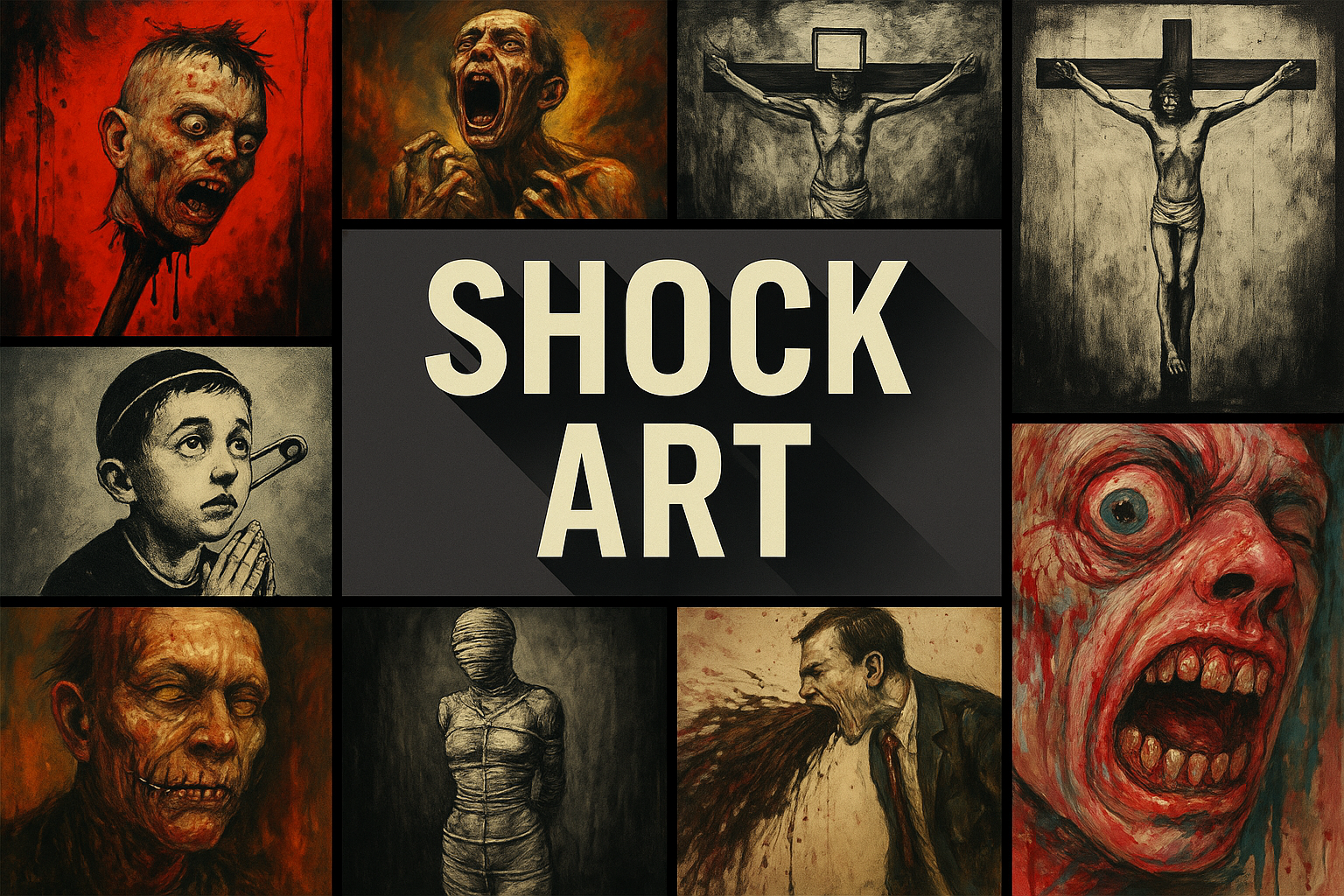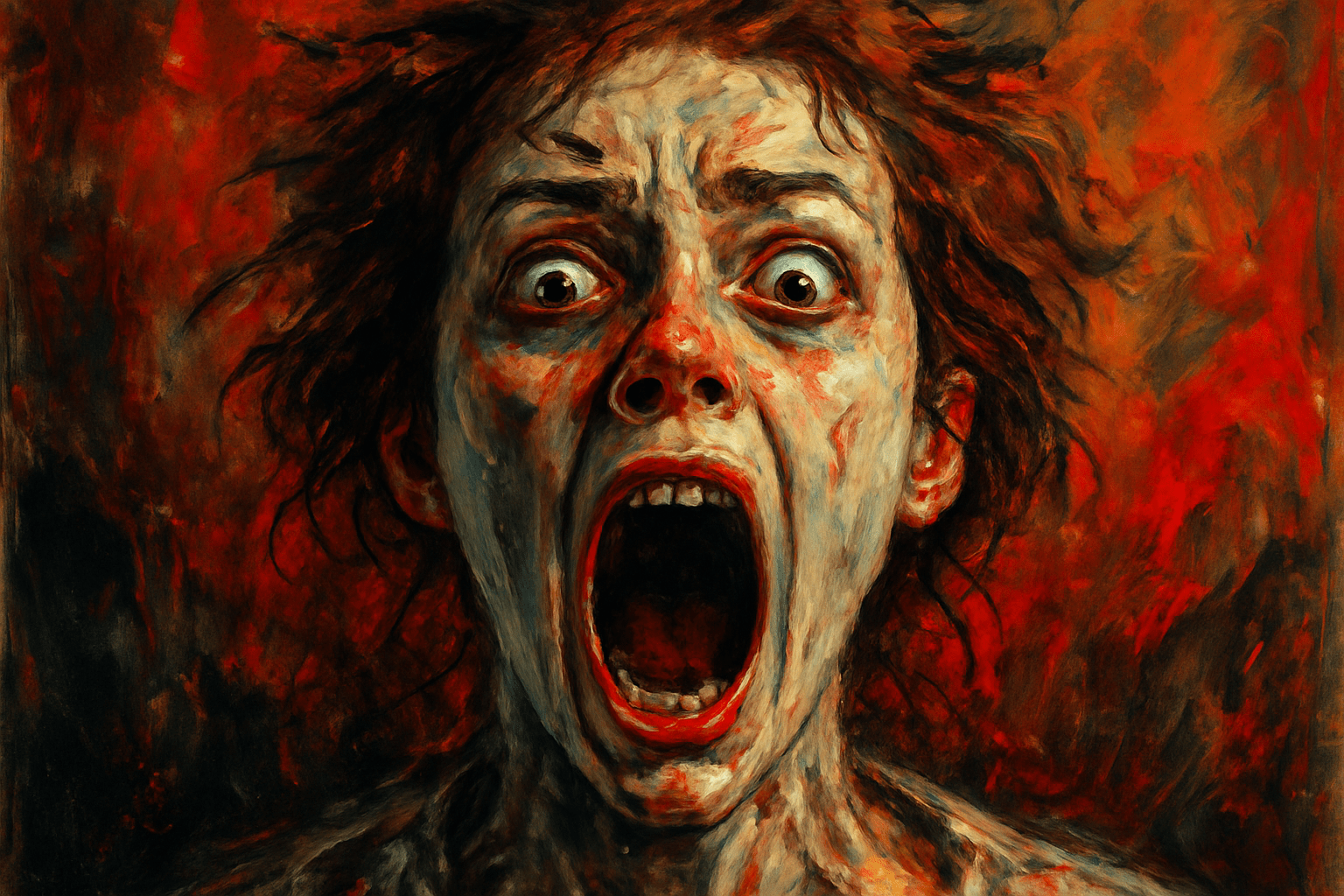
Shock art
The art style of shock art is characterized by its use of bright colors and bold patterns. It is often considered to be a more modern and contemporary style of art.
AOI thinking about Shock art [+_~]-/
Overview and Quickfacts
Shock art is a style of art that is designed to provoke an emotional reaction in the viewer. It is often controversial and can be offensive.
Can understand it also, as:
Aesthetic, avant-garde, conceptual, contemporary, experimental, installations, multimedia, new media, performance, site-specific, sound, video.
Categorize it as:
Impressionism, Modernism
.: Dreaming :.
holds a HAIKU for the art style
:. Thought is power .:
Detailed Description
Shock art is a style of art that is designed to provoke an emotional reaction in the viewer. It is often controversial and can be offensive. Shock art can be found in all mediums, including painting, sculpture, photography, and performance art. Some famous shock artists include Andres Serrano, who is best known for his photograph Piss Christ, which shows a crucifix submerged in urine. Another famous shock artist is Damien Hirst, who is known for his sculptures of dead animals, such as a shark preserved in formaldehyde. Shock art is often designed to challenge the viewer’s preconceptions about art and to provoke a reaction. It can be shocking, offensive, and even disturbing. However, it can also be thought-provoking and thought-provoking.
.. beep, beep, beep ..
<START OF TRANSMISSION>
1. Shock art is a type of art that is designed to provoke an emotional reaction in the viewer. 2. It can be shocking for its content, which may be graphic or offensive, or for its form, which may be unconventional or unexpected. 3. Shock art is often controversial, and its creators may be accused of being sensationalist or of exploiting shock value for commercial gain. 4. Some people believe that shock art is a legitimate form of expression, while others find it distasteful or offensive. 5. Shock art often deals with taboo subjects, such as violence, sex, or death. 6. It can be used to raise awareness about social issues, or to challenge the viewer's preconceptions about art. 7. Shock art is not new, but its popularity has increased in recent years due to the growth of the internet and social media. 8. Many shock artists use shock tactics to get their work noticed and to provoke debate. 9. Some shock artists have been criticized for their use of offensive or disturbing images. 10. Shock art can be divided into two main categories: visual shock art and performance shock art. 11. Visual shock art includes paintings, sculptures, photographs, and other visual media. 12. Performance shock art is a type of live art that often uses shock tactics to make a point or to provoke a reaction. 13. One of the most famous examples of shock art is Andres Serrano's photograph "Piss Christ," which shows a crucifix submerged in urine. 14. Another famous example of shock art is Damien Hirst's installation "The Physical Impossibility of Death in the Mind of Someone Living," which features a preserved shark in a tank of formaldehyde. 15. Shock art is often associated with the avant-garde and with artists who push the boundaries of what is considered acceptable. 16. Some people believe that shock art can be a valuable form of social commentary, while others find it to be in bad taste. 17. Shock art is often intended to provoke an emotional reaction, but it can also be humorous or thought-provoking. 18. Shock art can be found in a variety of settings, including art galleries, museums, and on the internet. 19. Shock art is not for everyone, and some people may find it disturbing or offensive. 20. If you are considering viewing or purchasing shock art, be sure to research the artist and the work in advance to ensure that it is something you are comfortable with.
<EOF>
.. robbel bob
Visual Examples from our image gallery
Coming soon, we are so slow .. might never come
Artists, Paintings, and more
(be aware, can be highly speculative)
Artists (be aware, speculation possible):
1. Francis Bacon (1909-1992) 2. Jean-Michel Basquiat (1960-1988) 3. Banksy (1974-) 4. Damien Hirst (1965-) 5. Jeff Koons (1955-) 6. Andy Warhol (1928-1987) 7. Robert Mapplethorpe (1946-1989) 8. Richard Hamilton (1922-2011) 9. Peter Blake (1932-) 10. Gilbert & George (1943-) 11. Richard Long (1945-) 12. Bruce McLean (1944-) 13. Frank Auerbach (1931-) 14. Lucian Freud (1922-2011) 15. David Hockney (1937-) 16. R. B. Kitaj (1932-2007) 17. Euan Uglow (1932-2000) 18. Patrick Caulfield (1936-2005) 19. Jannis Kounellis (1936-) 20. Mario Merz (1925-2003) 21. Giulio Paolini (1940-) 22. Pino Pascali (1935-1968) 23. Mimmo Rotella (1918-2006) 24. Salvatore Scarpitta (1919-2007) 25. Rudolf Stingel (1956-) 26. Cy Twombly (1928-2011) 27. Bill Viola (1951-) 28. Erwin Wurm (1954-) 29. Gilberto Zorio (1944-) 30. Sarah Lucas (1962-)
Artworks (be aware, speculation possible)
1. The Scream ÃÂÃÂ Edvard Munch, 1893 2. The Persistence of Memory ÃÂÃÂ Salvador Dali, 1931 3. Nighthawks ÃÂÃÂ Edward Hopper, 1942 4. American Gothic ÃÂÃÂ Grant Wood, 1930 5. The Dance of Life ÃÂÃÂ Edvard Munch, 1899 6. The Hay Wagon ÃÂÃÂ Andrew Wyeth, 1945 7. The Madonna of the Rocks ÃÂÃÂ Leonardo da Vinci, c. 1483-1486 8. The Last Supper ÃÂÃÂ Leonardo da Vinci, c. 1495-1498 9. The Birth of Venus ÃÂÃÂ Sandro Botticelli, c. 1486 10. The Sistine Chapel Ceiling ÃÂÃÂ Michelangelo, 1512 11. The Mona Lisa ÃÂÃÂ Leonardo da Vinci, c. 1503-1506 12. Guernica ÃÂÃÂ Pablo Picasso, 1937 13. The Starry Night ÃÂÃÂ Vincent van Gogh, 1889 14. The Cafe Terrace at Night ÃÂÃÂ Vincent van Gogh, 1888 15. The Yellow Christ ÃÂÃÂ Paul Gauguin, 1889 16. The Kiss ÃÂÃÂ Gustav Klimt, 1907-1908 17. The Great Wave off Kanagawa ÃÂÃÂ Katsushika Hokusai, c. 1830-1833 18. The Night Cafe ÃÂÃÂ Vincent van Gogh, 1888 19. The Haystacks ÃÂÃÂ Claude Monet, 1890-1891 20. The Water Lilies ÃÂÃÂ Claude Monet, 1906 21. The Arnolfini Portrait ÃÂÃÂ Jan van Eyck, 1434 22. The Ghent Altarpiece ÃÂÃÂ Jan van Eyck, c. 1432 23. The Bathers ÃÂÃÂ Paul Cezanne, 1898-1905 24. The Card Players ÃÂÃÂ Paul Cezanne, 1890-1892 25. Les Demoiselles d’Avignon ÃÂÃÂ Pablo Picasso, 1907 26. Nude Descending a Staircase, No. 2 ÃÂÃÂ Marcel Duchamp, 1912 27. Fountain ÃÂÃÂ Marcel Duchamp, 1917 28. L.H.O.O.Q. ÃÂÃÂ Marcel Duchamp, 1919 29. Portrait of Adele Bloch-Bauer I ÃÂÃÂ Gustav Klimt, 1907 30. The Screaming Pope ÃÂÃÂ Francis Bacon, 1950
Epoch
The time period of the art style Shock art is the early 1990s.
AI ART RESSOURCES (AKA, well Tools)
Helping tools -> predefined search links on other pages:











